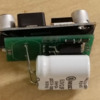I can see encoding the data in the MP3 secondary channel, that makes prefect sense. I'd probably not bother to try to make a full-up TMCC decoder, I'd just use a simplified serial decode.
One possibility is how I'm considering handling the TMCC option with the sound board. I've pretty much decided that I can only afford to produce one main board and one set of master software. If I replace the RF receiver with a simple board that just decodes the TMCC serial stream, I can use the RCDR receiver to receive TMCC and convert it to compatible RF receiver outputs.
If I replace the plug-in RF receiver with a small board with a uP and the audio detector/decoder, I could then simulate the command streams that would come from the RF remote. I would just pipe the secondary channel audio that I've thoughtfully provided (with a little prompting), and feed it in as the input to that board. That does beg the question of outside control, so I have to do more thinking on this. I think whatever I'd come up with for this option would be an add-on somehow.
One problem with a project like this is at some point you have to stop designing and start producing. ![]()










